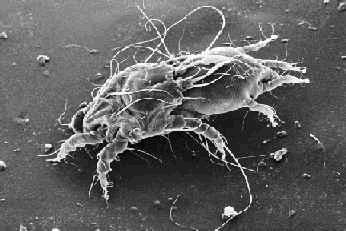| | Chorioptic mange on cattle is caused by the parasitic mite, Chorioptes bovis. It is one of the most common mites on cattle in Alberta.
These mites do not burrow deeply into the skin as do Sarcoptes scabiei, the cause of sarcoptic mange. Unlike sarcoptic mange, chorioptic mange is not a federally reportable disease.
Life cycle of Chorioptes bovis
The life cycle from egg to adult is completed in three weeks. The female lays her eggs on the surface of the skin, usually at the edge of a skin lesion.
When the egg hatches, it releases a larva that subsequently develops through two nymphal stages before developing into either a male or female mite. Females lay about one egg per day for up to 16 days. The eggs hatch within four days. Egg laying females may live as long as three weeks, adult males up to seven to eight weeks.

Figure 1. Mating pair of Chorioptes bovis mites. The male is on the left, female on the right
How do cattle get mange?
Infection is spread mainly by direct contact between cattle. However for animals housed in barns, grooming tools may become contaminated and help spread infection. These instruments should be thoroughly disinfected after each use. The mite can live for only a short time off the host, so ground-to-cow contamination is less common.
Are only cattle affected?
Chorioptic mites were formerly named after the host species they were found on. Now, it is thought that those on cattle, horses and sheep are one species, Chorioptes bovis.
Although the mite can potentially be transferred from other domestic animals to cattle, this probably rarely occurs. Most domestic animals would probably not come into close contact with cattle, so the likelihood of transferring infections is small. There also appear to be strain differences in mites so that those on horses and other domestic animals are not readily transferred to cattle, even when done experimentally.
How are cattle harmed by this mite?
Chorioptic mites do not burrow in the skin as do sarcoptic mites. Rather, they live at the base of the host's hair, where they feed on skin debris and tissue fluids.
The feeding activity produces an irritation to the skin of the cow. The infested animal may rub against objects to relieve the itchiness. This rubbing may cause skin lesions to form. The lesions may start as small nodules that exude serum, which hardens to form crusts. Later, the lesions may join to form heavy scabs. Affected areas may become thickened and wrinkled.
Does the mite occur all year round?
The heaviest infestations occur in late winter and early spring. At that time, the lesions occur most commonly on the perineum and udder, extending to the back of the legs as well as over the rump and base of the tail in severe cases. Light infestations occur during the summer months. During this time, Chorioptes may persist on the hind legs.
How will I know when my cattle have chorioptic mange?
Cattle may show little evidence of skin irritation, but small crusty scabs (approximately 3 mm in diameter) may be seen on the scrotum, udder, feet and thighs. Although Chorioptes causes few problems during the summer months, animals are occasionally seen with thick, crusty scabs.
How can I be sure my cattle have chorioptic mange?
Diagnosis is confirmed by finding the mite during microscopic examination of skin scrapings from affected areas. Mites can be isolated from animals that do not show clinical signs of disease. When scabs are present, the scraping should be taken at the edge of the lesion. Affected areas usually contain large numbers of mites.
Other parasitic or infectious agents may cause similar clinical signs. Chorioptic mange must be differentiated from sarcoptic mange, which is a federally reportable disease in Canada. Contact your veterinarian if mange is suspected.
How do I treat affected animals?
Several compounds are available for treating chorioptic mange. Contact your veterinarian for advice on the most suitable treatment program.
Prepared by:
Dr. Murray Kennedy, Food Safety Division
Source: Agdex 663-30. Revised April 2001. |
|